Macroeconomics: Concepts and Analysis
VerifiedAdded on 2023/06/07
|9
|1929
|233
AI Summary
This article covers various concepts of macroeconomics such as GDP, inflation, demand and supply, consumption function, and savings. It also discusses the impact of government expenditure on GDP growth.
Contribute Materials
Your contribution can guide someone’s learning journey. Share your
documents today.

[Type the document title]
STUDENT ID:
[Pick the date]
STUDENT ID:
[Pick the date]
Secure Best Marks with AI Grader
Need help grading? Try our AI Grader for instant feedback on your assignments.
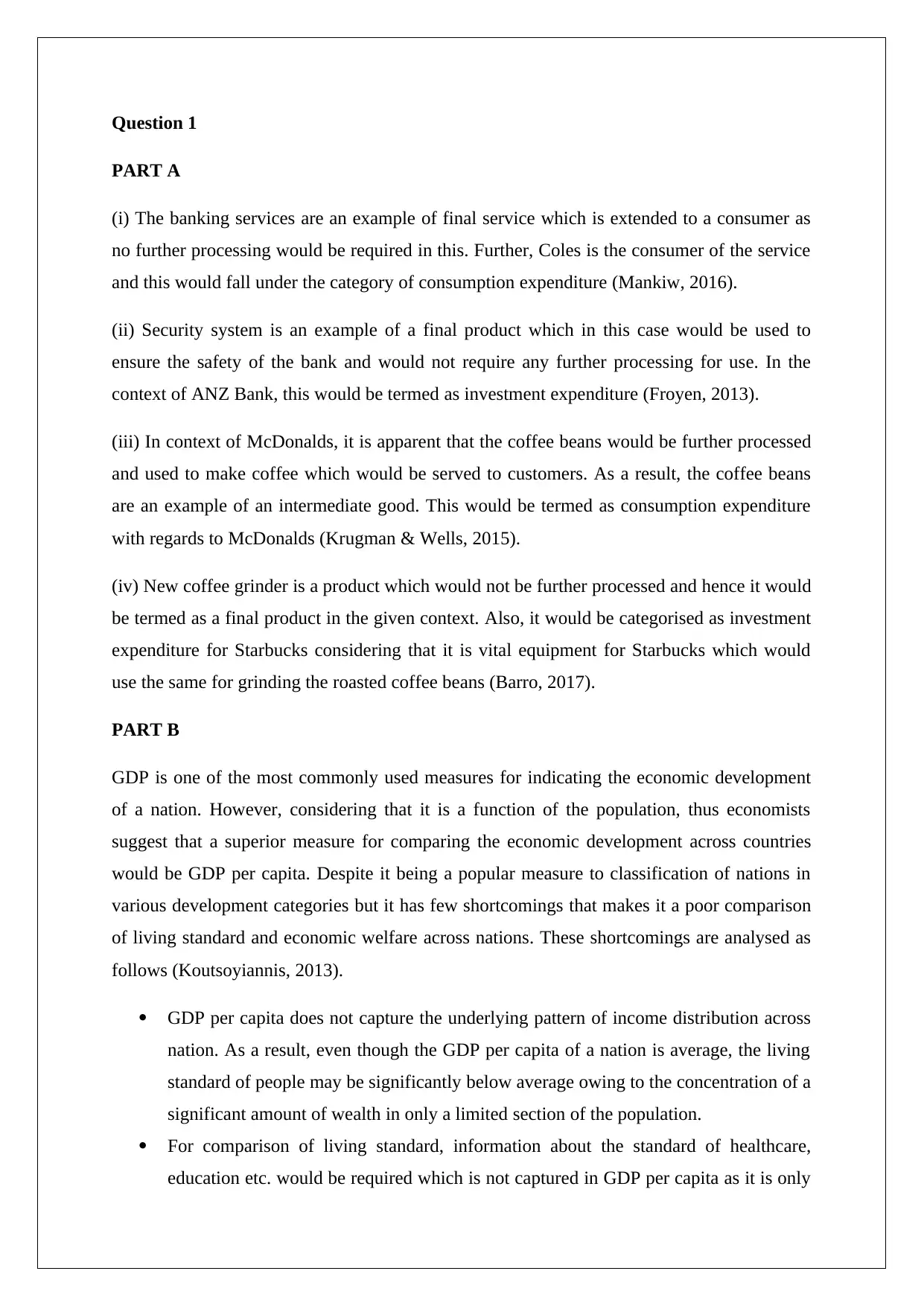
Question 1
PART A
(i) The banking services are an example of final service which is extended to a consumer as
no further processing would be required in this. Further, Coles is the consumer of the service
and this would fall under the category of consumption expenditure (Mankiw, 2016).
(ii) Security system is an example of a final product which in this case would be used to
ensure the safety of the bank and would not require any further processing for use. In the
context of ANZ Bank, this would be termed as investment expenditure (Froyen, 2013).
(iii) In context of McDonalds, it is apparent that the coffee beans would be further processed
and used to make coffee which would be served to customers. As a result, the coffee beans
are an example of an intermediate good. This would be termed as consumption expenditure
with regards to McDonalds (Krugman & Wells, 2015).
(iv) New coffee grinder is a product which would not be further processed and hence it would
be termed as a final product in the given context. Also, it would be categorised as investment
expenditure for Starbucks considering that it is vital equipment for Starbucks which would
use the same for grinding the roasted coffee beans (Barro, 2017).
PART B
GDP is one of the most commonly used measures for indicating the economic development
of a nation. However, considering that it is a function of the population, thus economists
suggest that a superior measure for comparing the economic development across countries
would be GDP per capita. Despite it being a popular measure to classification of nations in
various development categories but it has few shortcomings that makes it a poor comparison
of living standard and economic welfare across nations. These shortcomings are analysed as
follows (Koutsoyiannis, 2013).
GDP per capita does not capture the underlying pattern of income distribution across
nation. As a result, even though the GDP per capita of a nation is average, the living
standard of people may be significantly below average owing to the concentration of a
significant amount of wealth in only a limited section of the population.
For comparison of living standard, information about the standard of healthcare,
education etc. would be required which is not captured in GDP per capita as it is only
PART A
(i) The banking services are an example of final service which is extended to a consumer as
no further processing would be required in this. Further, Coles is the consumer of the service
and this would fall under the category of consumption expenditure (Mankiw, 2016).
(ii) Security system is an example of a final product which in this case would be used to
ensure the safety of the bank and would not require any further processing for use. In the
context of ANZ Bank, this would be termed as investment expenditure (Froyen, 2013).
(iii) In context of McDonalds, it is apparent that the coffee beans would be further processed
and used to make coffee which would be served to customers. As a result, the coffee beans
are an example of an intermediate good. This would be termed as consumption expenditure
with regards to McDonalds (Krugman & Wells, 2015).
(iv) New coffee grinder is a product which would not be further processed and hence it would
be termed as a final product in the given context. Also, it would be categorised as investment
expenditure for Starbucks considering that it is vital equipment for Starbucks which would
use the same for grinding the roasted coffee beans (Barro, 2017).
PART B
GDP is one of the most commonly used measures for indicating the economic development
of a nation. However, considering that it is a function of the population, thus economists
suggest that a superior measure for comparing the economic development across countries
would be GDP per capita. Despite it being a popular measure to classification of nations in
various development categories but it has few shortcomings that makes it a poor comparison
of living standard and economic welfare across nations. These shortcomings are analysed as
follows (Koutsoyiannis, 2013).
GDP per capita does not capture the underlying pattern of income distribution across
nation. As a result, even though the GDP per capita of a nation is average, the living
standard of people may be significantly below average owing to the concentration of a
significant amount of wealth in only a limited section of the population.
For comparison of living standard, information about the standard of healthcare,
education etc. would be required which is not captured in GDP per capita as it is only
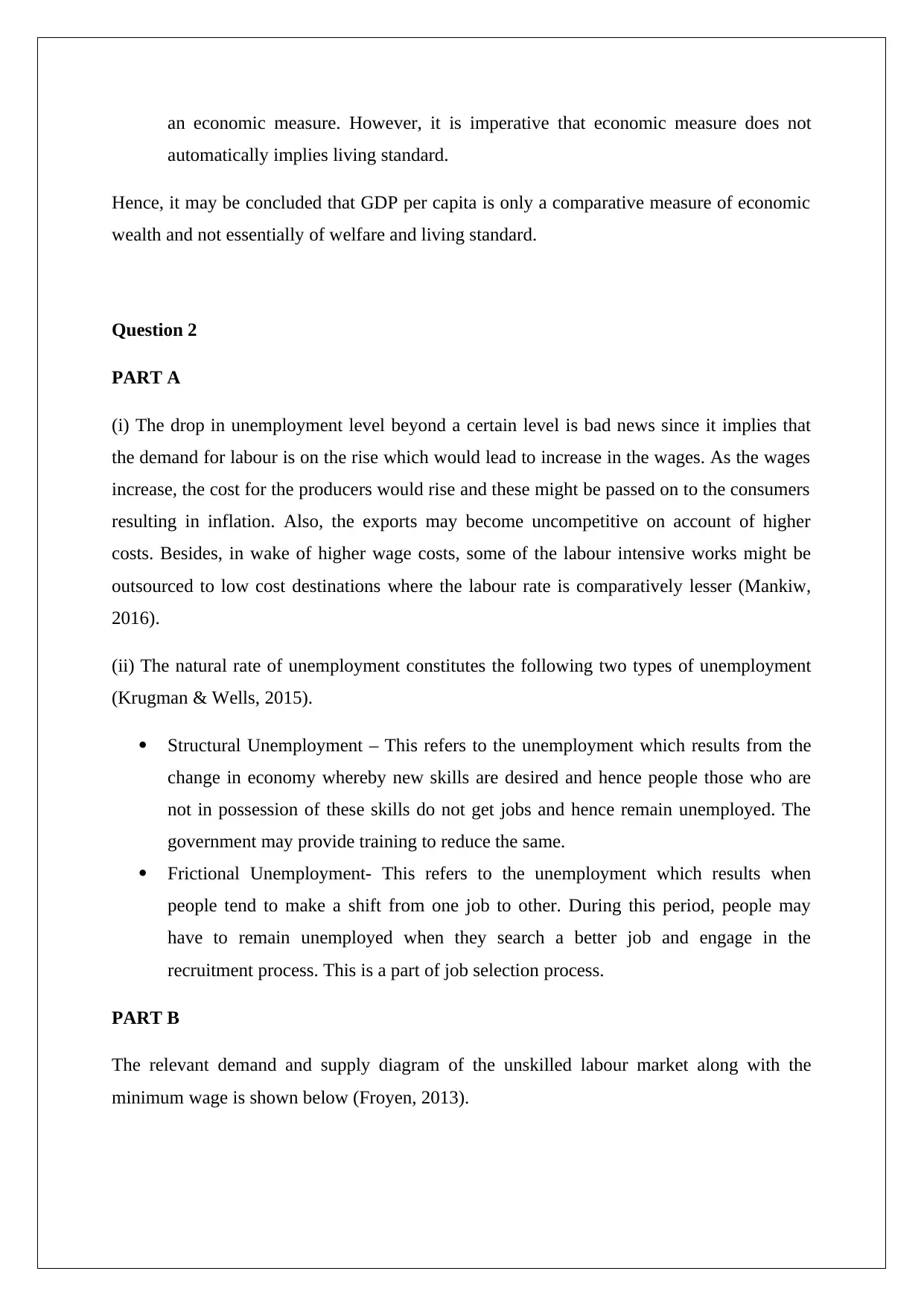
an economic measure. However, it is imperative that economic measure does not
automatically implies living standard.
Hence, it may be concluded that GDP per capita is only a comparative measure of economic
wealth and not essentially of welfare and living standard.
Question 2
PART A
(i) The drop in unemployment level beyond a certain level is bad news since it implies that
the demand for labour is on the rise which would lead to increase in the wages. As the wages
increase, the cost for the producers would rise and these might be passed on to the consumers
resulting in inflation. Also, the exports may become uncompetitive on account of higher
costs. Besides, in wake of higher wage costs, some of the labour intensive works might be
outsourced to low cost destinations where the labour rate is comparatively lesser (Mankiw,
2016).
(ii) The natural rate of unemployment constitutes the following two types of unemployment
(Krugman & Wells, 2015).
Structural Unemployment – This refers to the unemployment which results from the
change in economy whereby new skills are desired and hence people those who are
not in possession of these skills do not get jobs and hence remain unemployed. The
government may provide training to reduce the same.
Frictional Unemployment- This refers to the unemployment which results when
people tend to make a shift from one job to other. During this period, people may
have to remain unemployed when they search a better job and engage in the
recruitment process. This is a part of job selection process.
PART B
The relevant demand and supply diagram of the unskilled labour market along with the
minimum wage is shown below (Froyen, 2013).
automatically implies living standard.
Hence, it may be concluded that GDP per capita is only a comparative measure of economic
wealth and not essentially of welfare and living standard.
Question 2
PART A
(i) The drop in unemployment level beyond a certain level is bad news since it implies that
the demand for labour is on the rise which would lead to increase in the wages. As the wages
increase, the cost for the producers would rise and these might be passed on to the consumers
resulting in inflation. Also, the exports may become uncompetitive on account of higher
costs. Besides, in wake of higher wage costs, some of the labour intensive works might be
outsourced to low cost destinations where the labour rate is comparatively lesser (Mankiw,
2016).
(ii) The natural rate of unemployment constitutes the following two types of unemployment
(Krugman & Wells, 2015).
Structural Unemployment – This refers to the unemployment which results from the
change in economy whereby new skills are desired and hence people those who are
not in possession of these skills do not get jobs and hence remain unemployed. The
government may provide training to reduce the same.
Frictional Unemployment- This refers to the unemployment which results when
people tend to make a shift from one job to other. During this period, people may
have to remain unemployed when they search a better job and engage in the
recruitment process. This is a part of job selection process.
PART B
The relevant demand and supply diagram of the unskilled labour market along with the
minimum wage is shown below (Froyen, 2013).
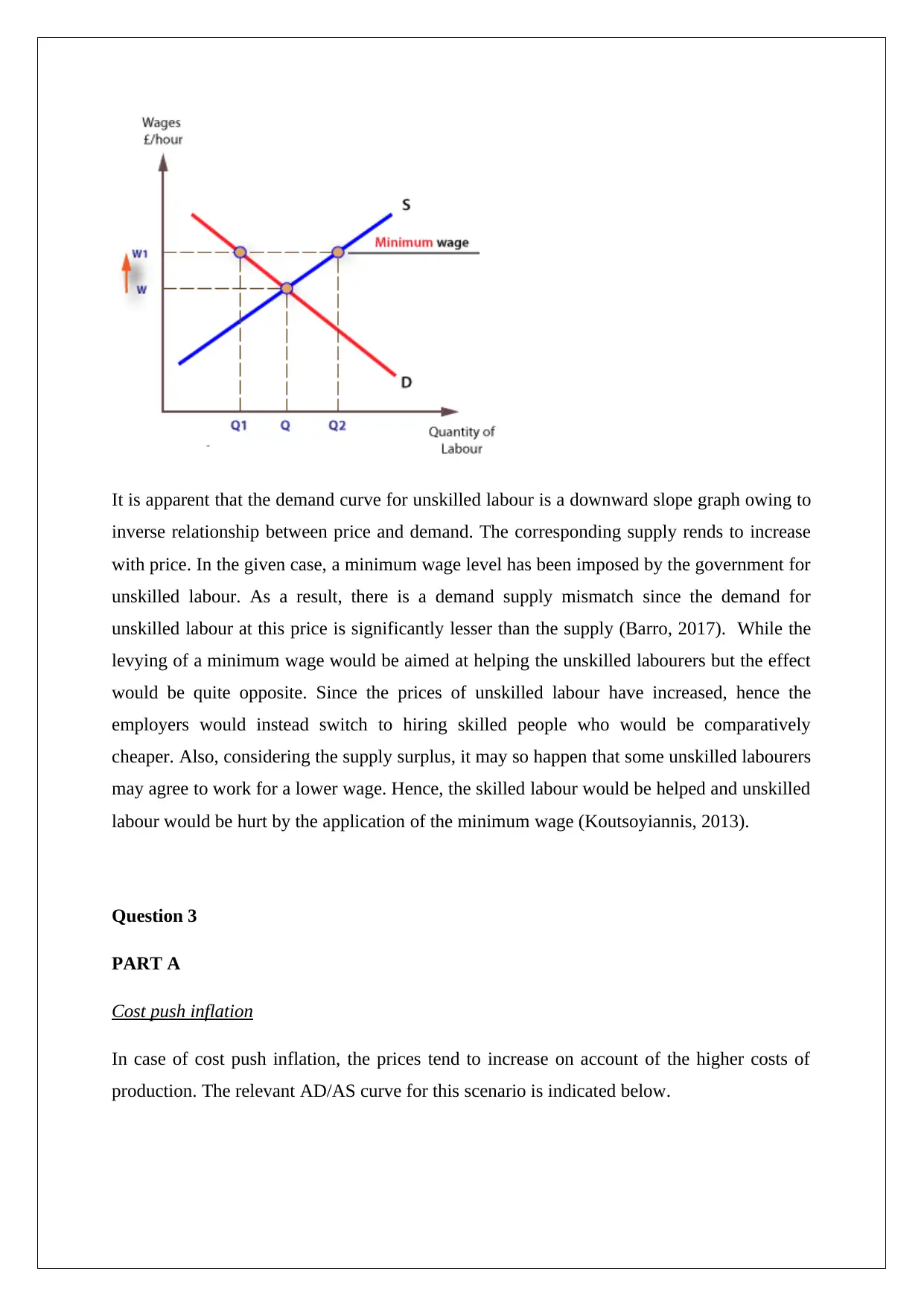
It is apparent that the demand curve for unskilled labour is a downward slope graph owing to
inverse relationship between price and demand. The corresponding supply rends to increase
with price. In the given case, a minimum wage level has been imposed by the government for
unskilled labour. As a result, there is a demand supply mismatch since the demand for
unskilled labour at this price is significantly lesser than the supply (Barro, 2017). While the
levying of a minimum wage would be aimed at helping the unskilled labourers but the effect
would be quite opposite. Since the prices of unskilled labour have increased, hence the
employers would instead switch to hiring skilled people who would be comparatively
cheaper. Also, considering the supply surplus, it may so happen that some unskilled labourers
may agree to work for a lower wage. Hence, the skilled labour would be helped and unskilled
labour would be hurt by the application of the minimum wage (Koutsoyiannis, 2013).
Question 3
PART A
Cost push inflation
In case of cost push inflation, the prices tend to increase on account of the higher costs of
production. The relevant AD/AS curve for this scenario is indicated below.
inverse relationship between price and demand. The corresponding supply rends to increase
with price. In the given case, a minimum wage level has been imposed by the government for
unskilled labour. As a result, there is a demand supply mismatch since the demand for
unskilled labour at this price is significantly lesser than the supply (Barro, 2017). While the
levying of a minimum wage would be aimed at helping the unskilled labourers but the effect
would be quite opposite. Since the prices of unskilled labour have increased, hence the
employers would instead switch to hiring skilled people who would be comparatively
cheaper. Also, considering the supply surplus, it may so happen that some unskilled labourers
may agree to work for a lower wage. Hence, the skilled labour would be helped and unskilled
labour would be hurt by the application of the minimum wage (Koutsoyiannis, 2013).
Question 3
PART A
Cost push inflation
In case of cost push inflation, the prices tend to increase on account of the higher costs of
production. The relevant AD/AS curve for this scenario is indicated below.
Secure Best Marks with AI Grader
Need help grading? Try our AI Grader for instant feedback on your assignments.
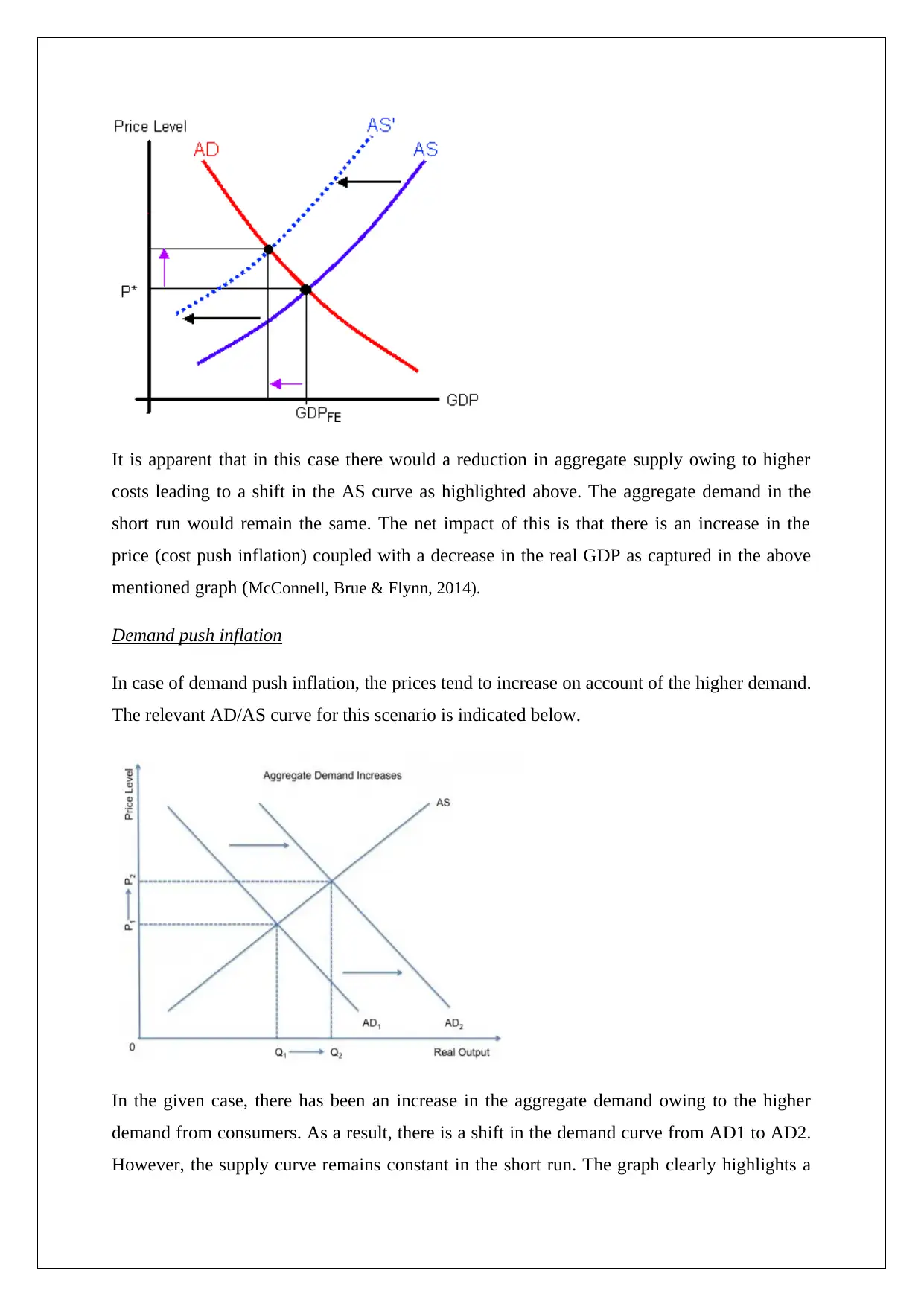
It is apparent that in this case there would a reduction in aggregate supply owing to higher
costs leading to a shift in the AS curve as highlighted above. The aggregate demand in the
short run would remain the same. The net impact of this is that there is an increase in the
price (cost push inflation) coupled with a decrease in the real GDP as captured in the above
mentioned graph (McConnell, Brue & Flynn, 2014).
Demand push inflation
In case of demand push inflation, the prices tend to increase on account of the higher demand.
The relevant AD/AS curve for this scenario is indicated below.
In the given case, there has been an increase in the aggregate demand owing to the higher
demand from consumers. As a result, there is a shift in the demand curve from AD1 to AD2.
However, the supply curve remains constant in the short run. The graph clearly highlights a
costs leading to a shift in the AS curve as highlighted above. The aggregate demand in the
short run would remain the same. The net impact of this is that there is an increase in the
price (cost push inflation) coupled with a decrease in the real GDP as captured in the above
mentioned graph (McConnell, Brue & Flynn, 2014).
Demand push inflation
In case of demand push inflation, the prices tend to increase on account of the higher demand.
The relevant AD/AS curve for this scenario is indicated below.
In the given case, there has been an increase in the aggregate demand owing to the higher
demand from consumers. As a result, there is a shift in the demand curve from AD1 to AD2.
However, the supply curve remains constant in the short run. The graph clearly highlights a
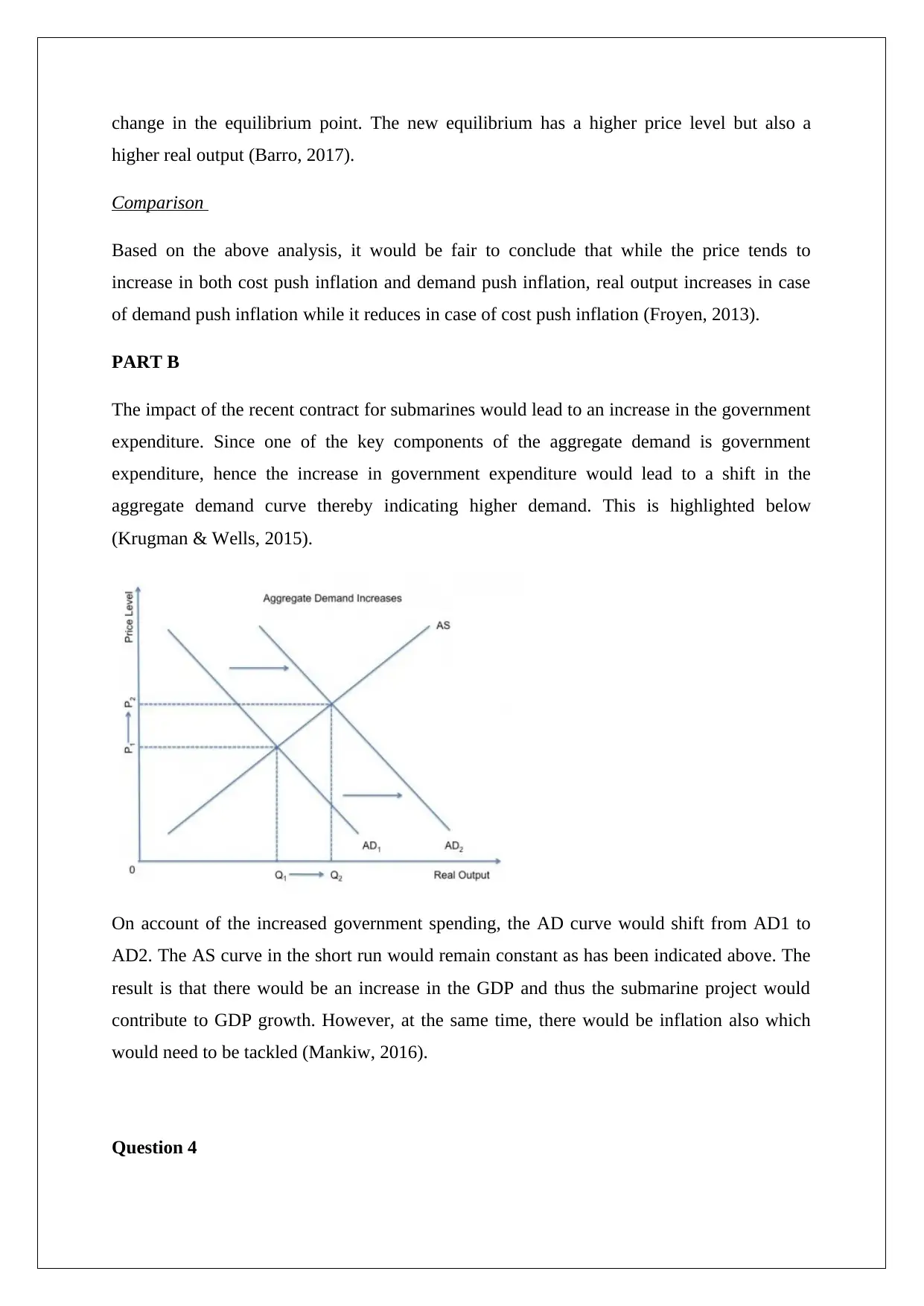
change in the equilibrium point. The new equilibrium has a higher price level but also a
higher real output (Barro, 2017).
Comparison
Based on the above analysis, it would be fair to conclude that while the price tends to
increase in both cost push inflation and demand push inflation, real output increases in case
of demand push inflation while it reduces in case of cost push inflation (Froyen, 2013).
PART B
The impact of the recent contract for submarines would lead to an increase in the government
expenditure. Since one of the key components of the aggregate demand is government
expenditure, hence the increase in government expenditure would lead to a shift in the
aggregate demand curve thereby indicating higher demand. This is highlighted below
(Krugman & Wells, 2015).
On account of the increased government spending, the AD curve would shift from AD1 to
AD2. The AS curve in the short run would remain constant as has been indicated above. The
result is that there would be an increase in the GDP and thus the submarine project would
contribute to GDP growth. However, at the same time, there would be inflation also which
would need to be tackled (Mankiw, 2016).
Question 4
higher real output (Barro, 2017).
Comparison
Based on the above analysis, it would be fair to conclude that while the price tends to
increase in both cost push inflation and demand push inflation, real output increases in case
of demand push inflation while it reduces in case of cost push inflation (Froyen, 2013).
PART B
The impact of the recent contract for submarines would lead to an increase in the government
expenditure. Since one of the key components of the aggregate demand is government
expenditure, hence the increase in government expenditure would lead to a shift in the
aggregate demand curve thereby indicating higher demand. This is highlighted below
(Krugman & Wells, 2015).
On account of the increased government spending, the AD curve would shift from AD1 to
AD2. The AS curve in the short run would remain constant as has been indicated above. The
result is that there would be an increase in the GDP and thus the submarine project would
contribute to GDP growth. However, at the same time, there would be inflation also which
would need to be tackled (Mankiw, 2016).
Question 4
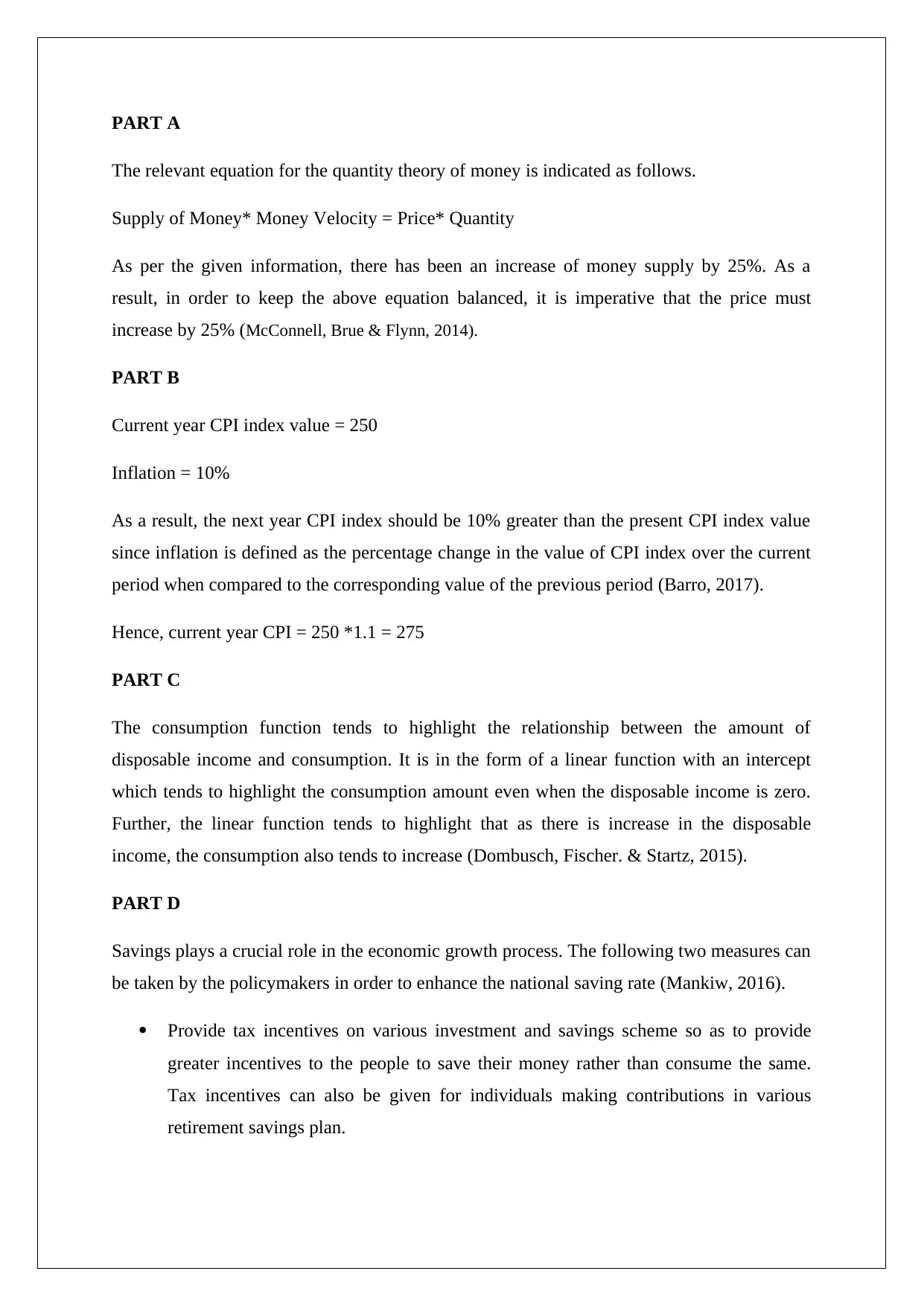
PART A
The relevant equation for the quantity theory of money is indicated as follows.
Supply of Money* Money Velocity = Price* Quantity
As per the given information, there has been an increase of money supply by 25%. As a
result, in order to keep the above equation balanced, it is imperative that the price must
increase by 25% (McConnell, Brue & Flynn, 2014).
PART B
Current year CPI index value = 250
Inflation = 10%
As a result, the next year CPI index should be 10% greater than the present CPI index value
since inflation is defined as the percentage change in the value of CPI index over the current
period when compared to the corresponding value of the previous period (Barro, 2017).
Hence, current year CPI = 250 *1.1 = 275
PART C
The consumption function tends to highlight the relationship between the amount of
disposable income and consumption. It is in the form of a linear function with an intercept
which tends to highlight the consumption amount even when the disposable income is zero.
Further, the linear function tends to highlight that as there is increase in the disposable
income, the consumption also tends to increase (Dombusch, Fischer. & Startz, 2015).
PART D
Savings plays a crucial role in the economic growth process. The following two measures can
be taken by the policymakers in order to enhance the national saving rate (Mankiw, 2016).
Provide tax incentives on various investment and savings scheme so as to provide
greater incentives to the people to save their money rather than consume the same.
Tax incentives can also be given for individuals making contributions in various
retirement savings plan.
The relevant equation for the quantity theory of money is indicated as follows.
Supply of Money* Money Velocity = Price* Quantity
As per the given information, there has been an increase of money supply by 25%. As a
result, in order to keep the above equation balanced, it is imperative that the price must
increase by 25% (McConnell, Brue & Flynn, 2014).
PART B
Current year CPI index value = 250
Inflation = 10%
As a result, the next year CPI index should be 10% greater than the present CPI index value
since inflation is defined as the percentage change in the value of CPI index over the current
period when compared to the corresponding value of the previous period (Barro, 2017).
Hence, current year CPI = 250 *1.1 = 275
PART C
The consumption function tends to highlight the relationship between the amount of
disposable income and consumption. It is in the form of a linear function with an intercept
which tends to highlight the consumption amount even when the disposable income is zero.
Further, the linear function tends to highlight that as there is increase in the disposable
income, the consumption also tends to increase (Dombusch, Fischer. & Startz, 2015).
PART D
Savings plays a crucial role in the economic growth process. The following two measures can
be taken by the policymakers in order to enhance the national saving rate (Mankiw, 2016).
Provide tax incentives on various investment and savings scheme so as to provide
greater incentives to the people to save their money rather than consume the same.
Tax incentives can also be given for individuals making contributions in various
retirement savings plan.
Paraphrase This Document
Need a fresh take? Get an instant paraphrase of this document with our AI Paraphraser
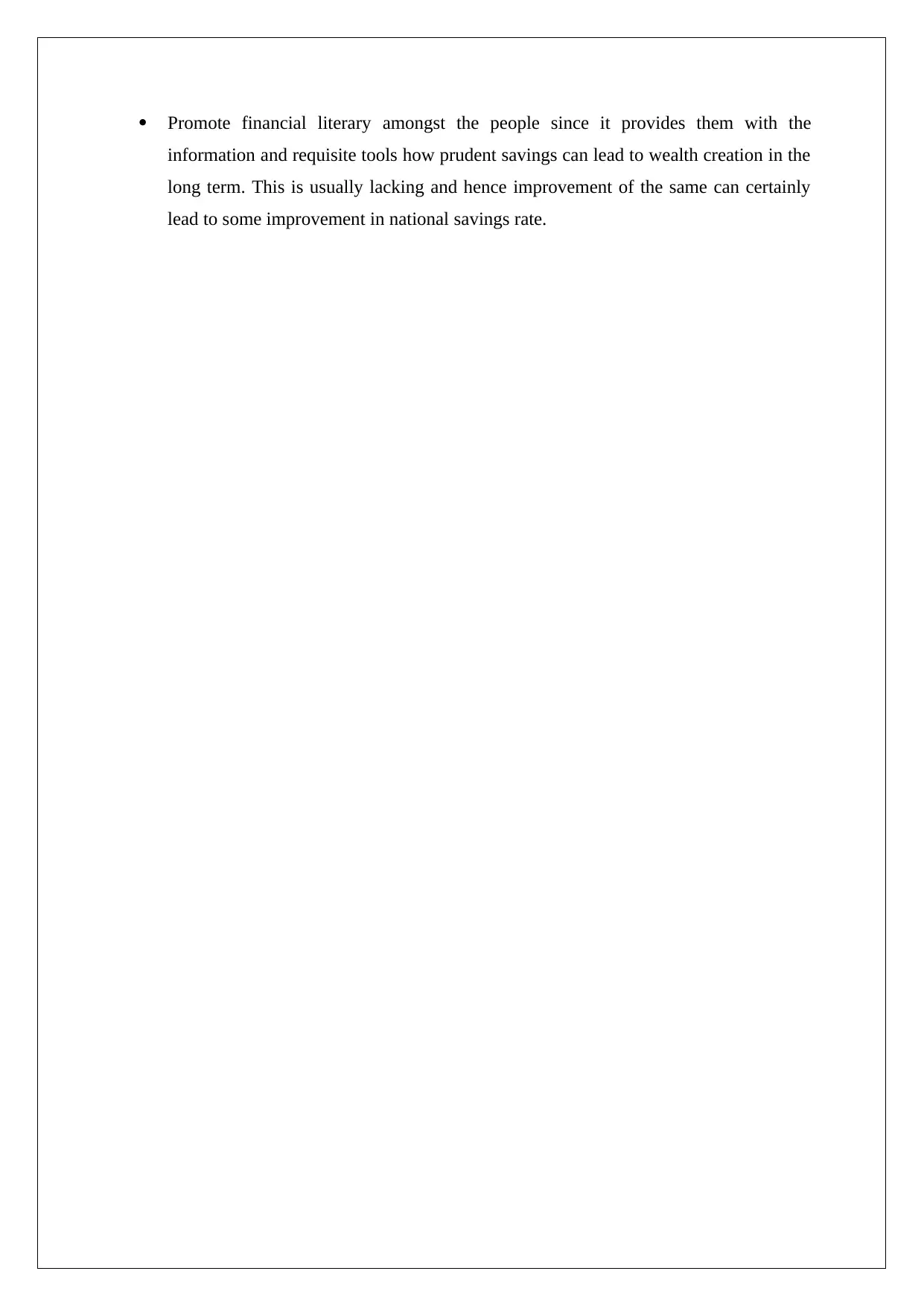
Promote financial literary amongst the people since it provides them with the
information and requisite tools how prudent savings can lead to wealth creation in the
long term. This is usually lacking and hence improvement of the same can certainly
lead to some improvement in national savings rate.
information and requisite tools how prudent savings can lead to wealth creation in the
long term. This is usually lacking and hence improvement of the same can certainly
lead to some improvement in national savings rate.
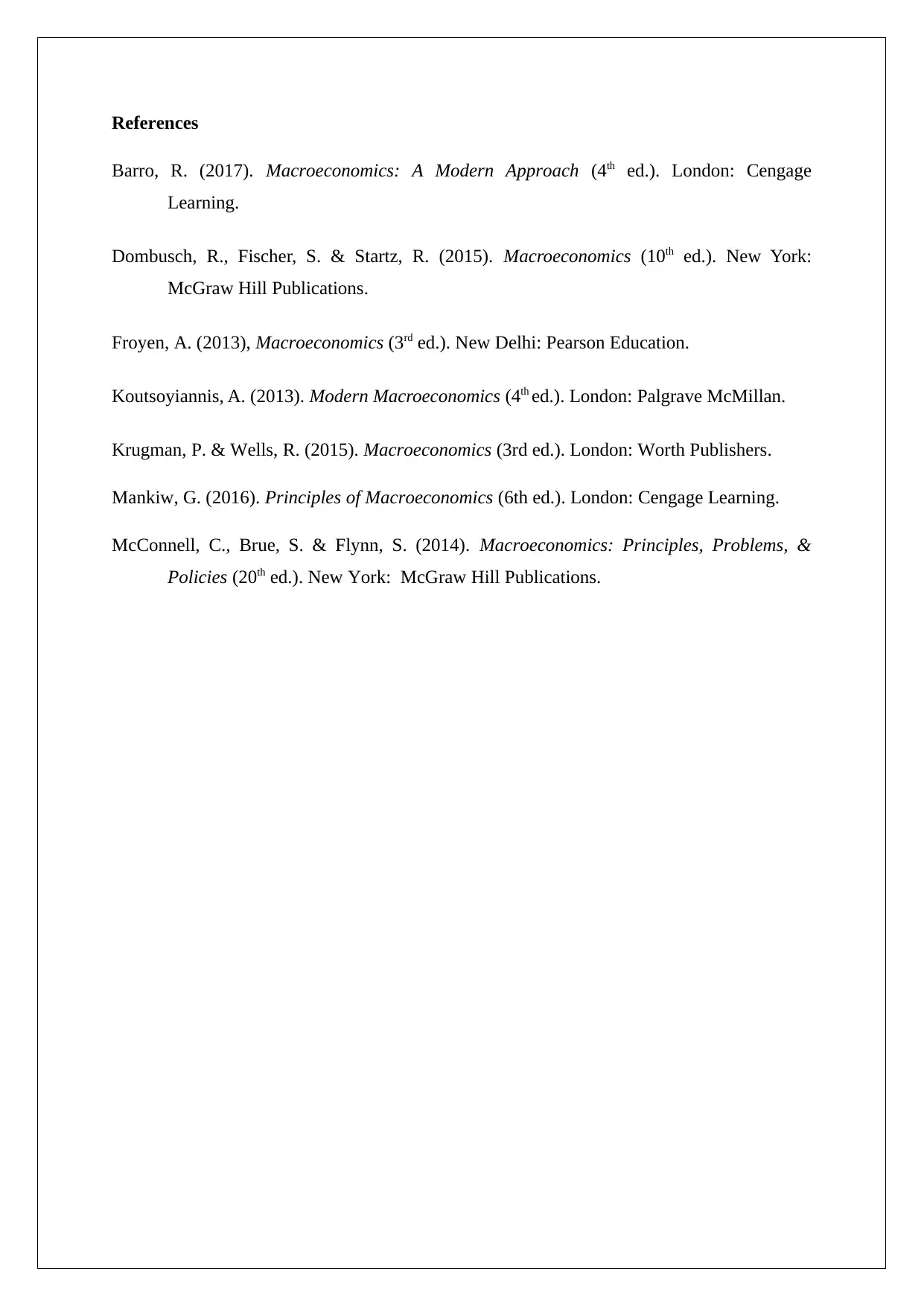
References
Barro, R. (2017). Macroeconomics: A Modern Approach (4th ed.). London: Cengage
Learning.
Dombusch, R., Fischer, S. & Startz, R. (2015). Macroeconomics (10th ed.). New York:
McGraw Hill Publications.
Froyen, A. (2013), Macroeconomics (3rd ed.). New Delhi: Pearson Education.
Koutsoyiannis, A. (2013). Modern Macroeconomics (4th ed.). London: Palgrave McMillan.
Krugman, P. & Wells, R. (2015). Macroeconomics (3rd ed.). London: Worth Publishers.
Mankiw, G. (2016). Principles of Macroeconomics (6th ed.). London: Cengage Learning.
McConnell, C., Brue, S. & Flynn, S. (2014). Macroeconomics: Principles, Problems, &
Policies (20th ed.). New York: McGraw Hill Publications.
Barro, R. (2017). Macroeconomics: A Modern Approach (4th ed.). London: Cengage
Learning.
Dombusch, R., Fischer, S. & Startz, R. (2015). Macroeconomics (10th ed.). New York:
McGraw Hill Publications.
Froyen, A. (2013), Macroeconomics (3rd ed.). New Delhi: Pearson Education.
Koutsoyiannis, A. (2013). Modern Macroeconomics (4th ed.). London: Palgrave McMillan.
Krugman, P. & Wells, R. (2015). Macroeconomics (3rd ed.). London: Worth Publishers.
Mankiw, G. (2016). Principles of Macroeconomics (6th ed.). London: Cengage Learning.
McConnell, C., Brue, S. & Flynn, S. (2014). Macroeconomics: Principles, Problems, &
Policies (20th ed.). New York: McGraw Hill Publications.
1 out of 9
Related Documents
Your All-in-One AI-Powered Toolkit for Academic Success.
+13062052269
info@desklib.com
Available 24*7 on WhatsApp / Email
![[object Object]](/_next/static/media/star-bottom.7253800d.svg)
Unlock your academic potential
© 2024 | Zucol Services PVT LTD | All rights reserved.





